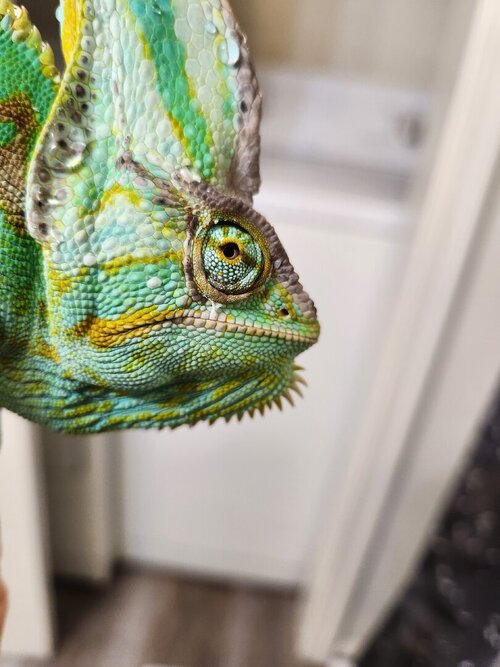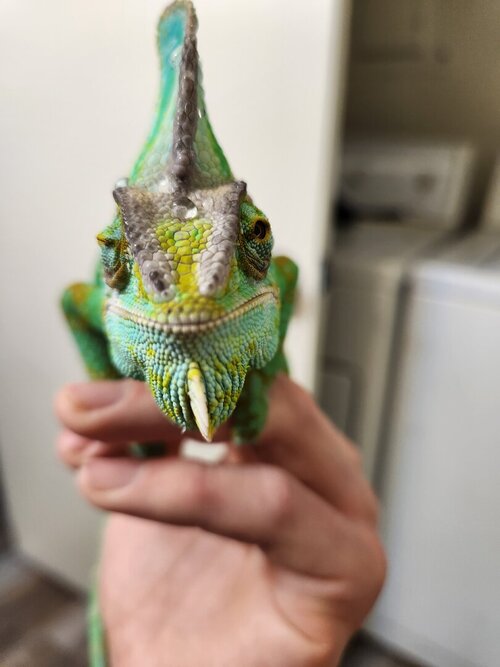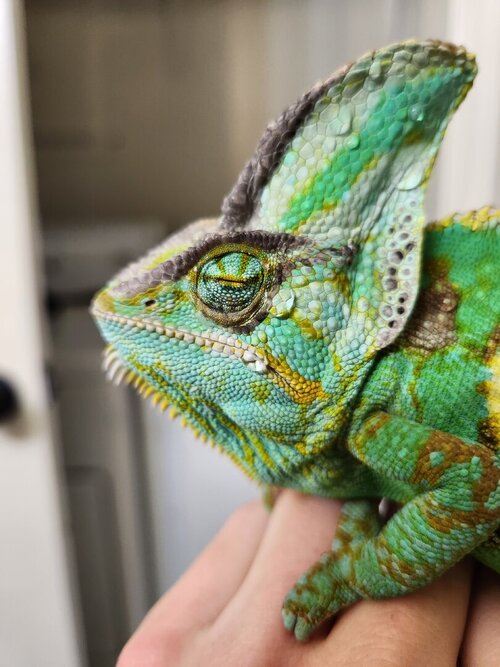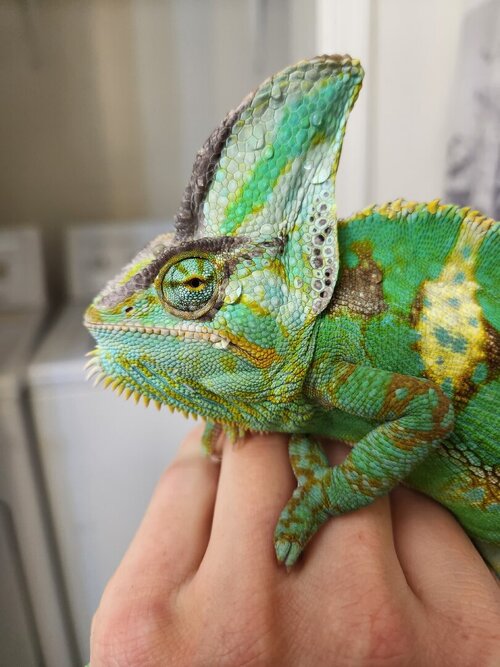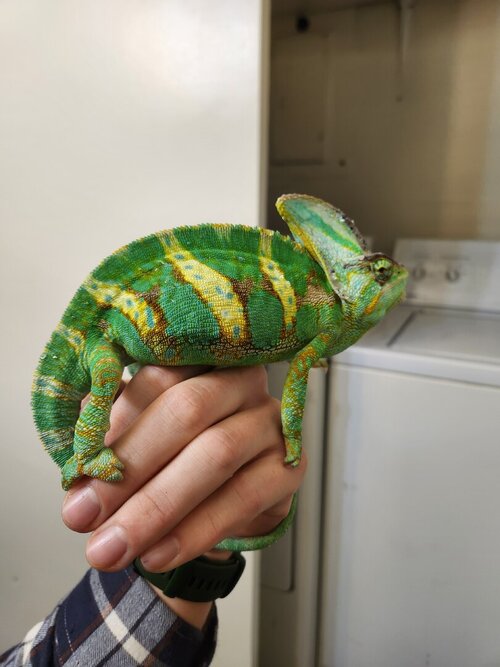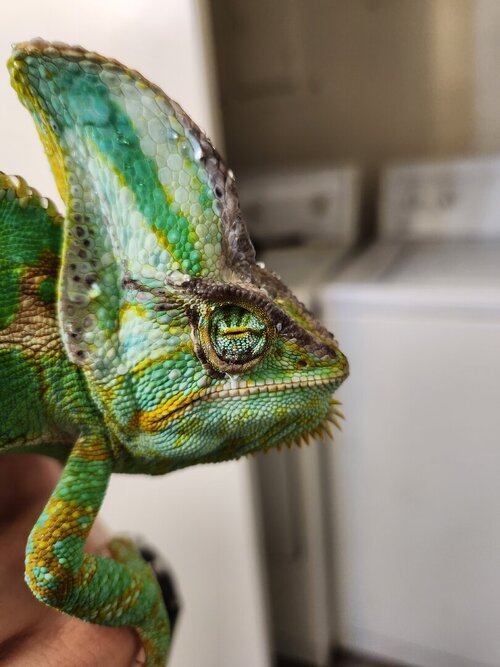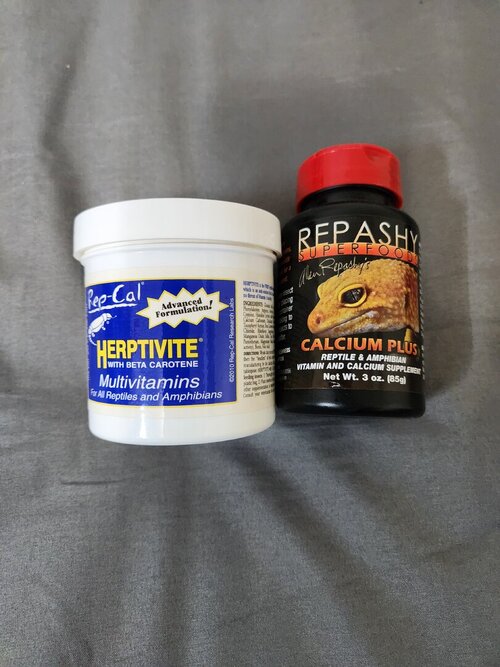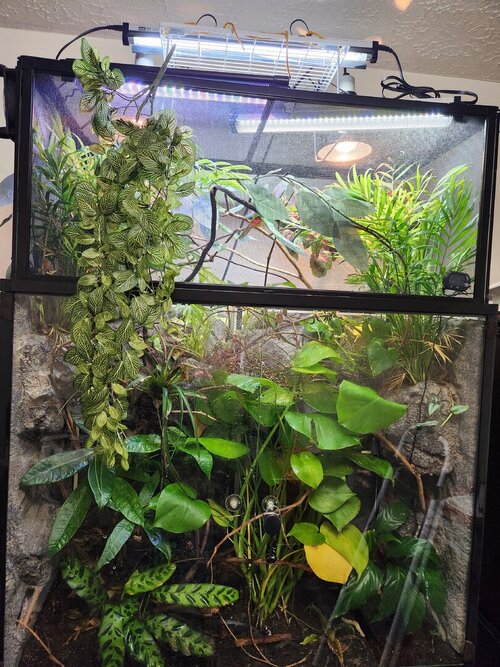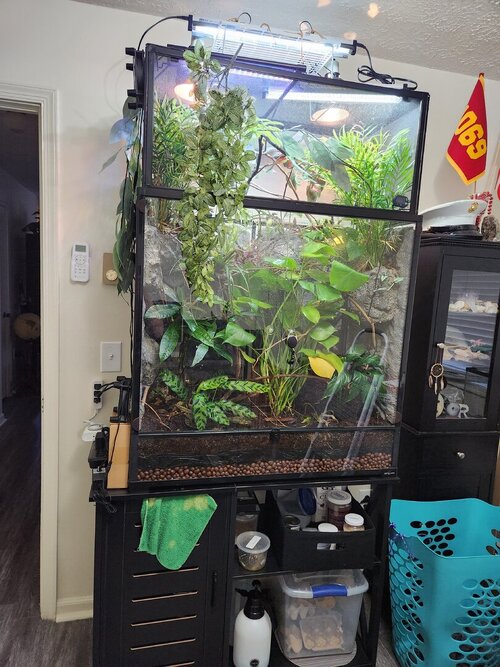I have a male veiled chameleon named Shadewood that I've had for about 6 months now. I am his second owner even though he is not quite a year old yet. More details on care included at the end.
Shadewood has been having a hard time with his eyes for the last 4-ish weeks. It all started when his eye sockets shed. I first noticed him once in a while scratching his eyes on the branches around this time. The weather had been dryer than normal and I noticed the humidity levels were below the usual 60-70% daytime humidity. As a result, I added a second humidifier to keep the room humidity above 60% and increased auto misting from two to three times a day at 60s each session. This seemed to help but did not fix the issue. His eyes began to sink in and I even caught them puffed out slightly more than normal every so often. I also would catch him with one or both of his eyes closed, so I became pretty concerned. I noticed he had shed still around his eyes about a week after the shedding, so I made several attempts over the next days to gently remove it with a wet cotton swab, which he clearly appreciated.
With most of the shed removed, his eyes seemed to be in less pain as I didnt catch them closed very frequently anymore. However, they were moderately sunken. I suspected the dry weather had made him more dehydrated, which was confirmed by a yellow-to-orange urate sack. I gave him fluids orally with a syringe over the next couple days. His next urate came back a white color with very faint yellow, so I knew this had helped. The sunken and closing eyes are not better yet though, so I'm wondering if I should take him to the vet to get checked out further. He could have shed stuck in his eye.
I just today put him in his screen travel cage and gave him a shower with indirect mist. I used this opportunity to remove any other small particles of shed with a wet swab and used the syringe to try and help gently rinse out his eye sockets. Its hard to say if that helped rn but I got some good pictures of his eyes during the process, as attached.
As for other things to note, his grip is very strong, he eats alot, and has not been lethargic. These make me suspect this is not an infection which is why I have not taken him to the vet yet. I dont handle him very often, although I do feed him by hand when he will let me. He gets fed mostly dubias, but also some crickets and superworms, and hornworms or silkworms when available. The dubias amd crickets are gutloaded with flukers calcium diet, and I dust with herptivite multivitamins twice a month. Watering was covered. Feces is normal. His cage is a 36x36x18 glass terrarium with a DIY screen extension that adds about 18 inches of additional height. I use arcadia UVB and lighting, two heatlamps regulated around 90F for his basking spots, and have two ventilation fans that I can turn on when humidity is too high (they are seldom used in this dry weather). The terrarium has many live plants and is bioactive. He loves to chow down on syngonium anytime I put a new one in there, he's a lawnmower. The room has a wall mounted unit which I don't use this time of year because it blows right onto his basking spot and could dry him out. I am located in southwestern Virginia.
Shadewood has been having a hard time with his eyes for the last 4-ish weeks. It all started when his eye sockets shed. I first noticed him once in a while scratching his eyes on the branches around this time. The weather had been dryer than normal and I noticed the humidity levels were below the usual 60-70% daytime humidity. As a result, I added a second humidifier to keep the room humidity above 60% and increased auto misting from two to three times a day at 60s each session. This seemed to help but did not fix the issue. His eyes began to sink in and I even caught them puffed out slightly more than normal every so often. I also would catch him with one or both of his eyes closed, so I became pretty concerned. I noticed he had shed still around his eyes about a week after the shedding, so I made several attempts over the next days to gently remove it with a wet cotton swab, which he clearly appreciated.
With most of the shed removed, his eyes seemed to be in less pain as I didnt catch them closed very frequently anymore. However, they were moderately sunken. I suspected the dry weather had made him more dehydrated, which was confirmed by a yellow-to-orange urate sack. I gave him fluids orally with a syringe over the next couple days. His next urate came back a white color with very faint yellow, so I knew this had helped. The sunken and closing eyes are not better yet though, so I'm wondering if I should take him to the vet to get checked out further. He could have shed stuck in his eye.
I just today put him in his screen travel cage and gave him a shower with indirect mist. I used this opportunity to remove any other small particles of shed with a wet swab and used the syringe to try and help gently rinse out his eye sockets. Its hard to say if that helped rn but I got some good pictures of his eyes during the process, as attached.
As for other things to note, his grip is very strong, he eats alot, and has not been lethargic. These make me suspect this is not an infection which is why I have not taken him to the vet yet. I dont handle him very often, although I do feed him by hand when he will let me. He gets fed mostly dubias, but also some crickets and superworms, and hornworms or silkworms when available. The dubias amd crickets are gutloaded with flukers calcium diet, and I dust with herptivite multivitamins twice a month. Watering was covered. Feces is normal. His cage is a 36x36x18 glass terrarium with a DIY screen extension that adds about 18 inches of additional height. I use arcadia UVB and lighting, two heatlamps regulated around 90F for his basking spots, and have two ventilation fans that I can turn on when humidity is too high (they are seldom used in this dry weather). The terrarium has many live plants and is bioactive. He loves to chow down on syngonium anytime I put a new one in there, he's a lawnmower. The room has a wall mounted unit which I don't use this time of year because it blows right onto his basking spot and could dry him out. I am located in southwestern Virginia.

